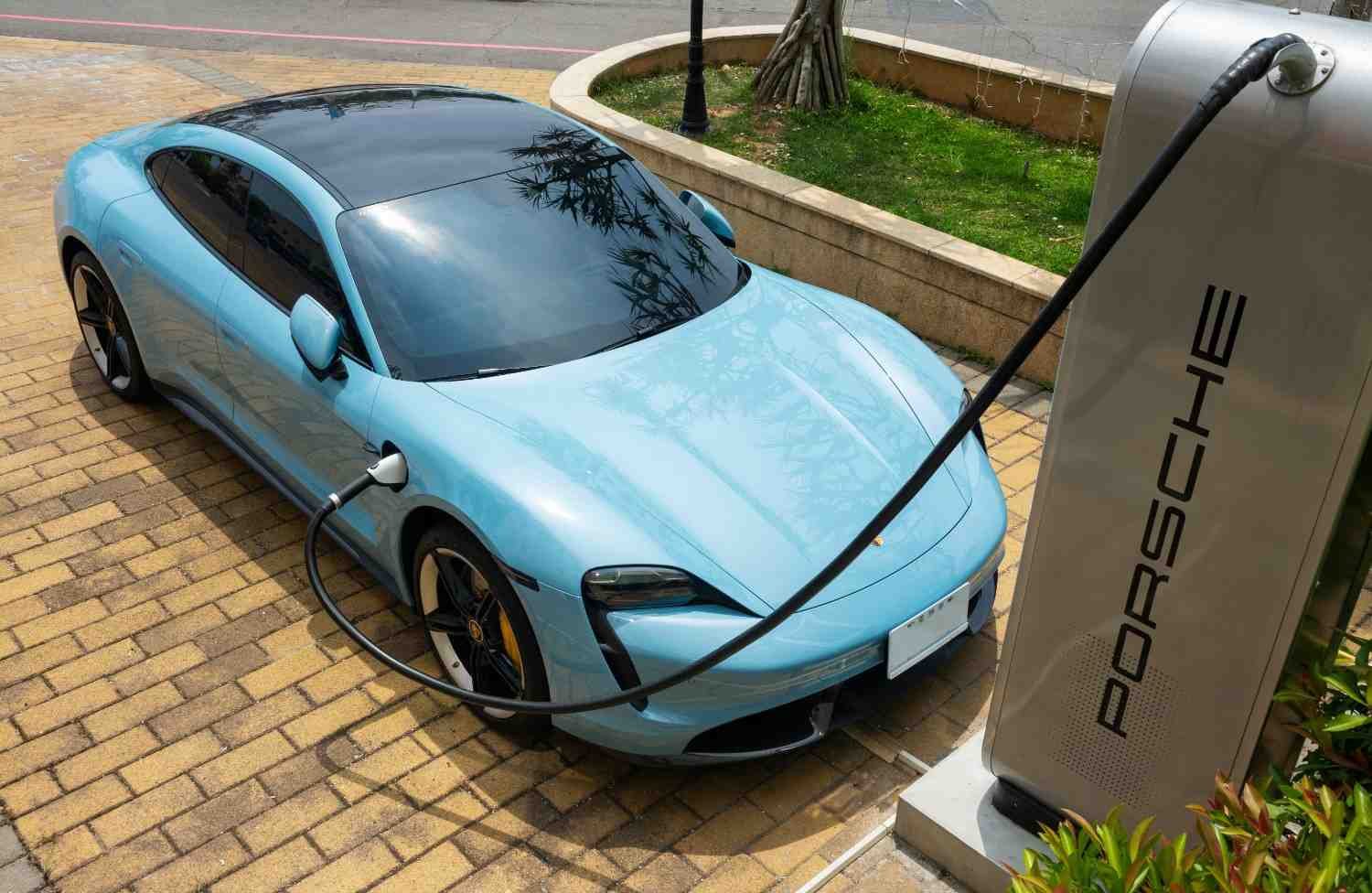EV Myth Busting: The electricity for EV charging is bad for the environment
Key insights:
UK electricity generation has become significantly greener, with zero-carbon power growing from under 20% in 2010 to 50% in 2021, and December 2023 marked the fifteenth consecutive month where clean energy outproduced fossil fuels.
While electric vehicles do have environmental impacts during manufacturing (particularly battery production), their lifetime carbon emissions are substantially lower than petrol or diesel vehicles, which continue polluting throughout their entire operational life.
EV owners can further reduce their environmental impact by charging during off-peak hours when less fossil fuel generation is needed, and by selecting renewable energy tariffs for home charging, making electric vehicles an increasingly sustainable transportation option.
We know that switching to an electric car is one of the most significant ways to make a difference to an individual's carbon footprint, especially if they drive every day. Rising concerns over the climate emergency have led to the decarbonisation of our transport networks and, therefore, more people are driving electric. In the UK, from 2035, the sale of petrol, diesel, and hybrid cars will be banned. The sale and purchase of second-hand petrol or diesel cars will still be allowed. Because the rise of electric cars on the roads is relatively new for many people, many EV sceptics and myths circulate, giving people the wrong information about electric cars.
At The Electric Car Scheme, we have started a series called ‘EV Myth Busting’. This will be the third article in the instalment. The first is about The Grid and Charging, which dispels myths about the electricity grid not having enough capacity to deal with the surge of EVs. You can also read our article about electric cars breaking down more than petrol cars, which is dispelled by looking at statistics.
In this instalment of EV Myth Busting, we will be looking at where the electricity for EV charging comes from and how good it is for the environment. We will look at decarbonising the grid, carbon offsetting, and clean energy providers to choose from!
Electricity versus fuel: what is better?
Electric vehicles have zero tailpipe emissions, which means no exhaust emissions are emitting harmful gases (like CO2 emissions). In contrast, internal combustion engines, such as petrol and diesel cars, emit harmful gases that ultimately contribute to climate change and poor air quality. There are some CO2 emissions associated with the electricity generated used to power EVs, but these emissions are significantly lower than those from an ICE vehicle.
More of our electricity in the UK now comes from renewable, green, or clean energy sources. According to the National Grid, the share of zero-carbon power in Britain’s electricity mix has grown from less than 20% in 2010 to 50% in 2021. There has been growth in onshore and offshore wind farms, as well as the closure of several coal plants, which is positive!
The energy system in the UK is becoming more flexible to maximise cleaner energy where possible. New legislation and smart energy tariffs are helping to manage electricity use. One way to reduce emissions produced through electricity is by charging your EV at night when fewer fossil fuels are needed to generate electricity.
How is electricity generated using fossil fuels?
Gas is the fossil fuel used to generate electricity - we burn gas to create heat which powers a turbine - the rotation of the turbine spins a generator which then generates electricity. As mentioned previously, the UK is becoming less reliant on fossil fuels but it is still used to ensure we have a secure supply of electricity across the country.
What renewables are used to generate electricity?
There are four main renewable energy sources used to generate power in the UK. These are wind, solar, hydroelectricity and bioenergy. In 2023, individual renewables contributed the following:
Wind contributed 29.4% of the UK’s total electricity generation,
Bioenergy refers to the burning of renewable organic materials and contributed 5% to the renewable energy mix,
Solar power contributed 4.9% to the renewable mix,
Hydropower contributed to 1.8% of the mix.
December 2023 was the fifteenth consecutive month where zero-carbon generation produced more than fossil fuel generation. 2023 was the greenest year on record! This is positive and shows that we can increase the UK’s reliance on renewable energy sources. Plans are in action to increase offshore wind’s output to 50GW by 2030 and solar capacity is expected to grow significantly in the same period.
Why are fuels like petrol and diesel so bad for the environment?
This may seem obvious, but it is important to understand why fuels like petrol and diesel are so bad for the environment. When fossil fuels are burned, they release large amounts of carbon dioxide into the air. Carbon dioxide is a greenhouse gas and it traps heat in our atmosphere, causing global warming.
What is worse for the environment: petrol or diesel?
Initially, diesel cars were promoted to be better for the environment than petrol. This was because diesel engines are more efficient than petrol and therefore they can do more mileage. However, diesel and petrol are both made from crude oil. The combustion of 1 litre of diesel releases approximately 13% more CO2 than the same amount of petrol. This ultimately means diesel is worse for the environment than petrol!
If you’re interested in comparing electric and petrol cars, we have written a blog that looks at the costs, insurance, congestion charges and more. These are all important things to consider if you’re looking to buy or lease a new car. It may be time to replace your petrol car with an electric one!
Are electric cars actually better for the environment?
In short, yes.
They produce no tailpipe emissions, which means they do not contribute to air pollution. As discussed, this does not mean that electric cars are 100% emission-free, some areas of their lifecycle such as charging and production still produce greenhouse gases and air pollutants.
Overall, when comparing the carbon emissions of an electric car with petrol or diesel car over their lifetime, electric cars produce much less than an internal combustion engine.
Electric car batteries are bad for the environment to produce
There is a lot of discussion around electric car batteries, and how they are not environmentally friendly as they are difficult to recycle. However, according to the SMMT’s 2023 Automotive Sustainability Report, car manufacturers must ensure that at least 95% of any car they manufacture is recycled, re-used or recovered.
Electric car batteries have an average lifespan of 15 to 20 years, after the battery’s performance drops below 70% or less it will start its “second life”. This is when an electric car battery will be removed from a car and used for other purposes. Some car manufacturers have already begun repurposing EV batteries to power other things - for example, Nissan is using them as backup power for Amsterdam Arena.
What is carbon offsetting?
Carbon offsetting refers to a reduction in greenhouse gas emissions used to compensate for emissions that occur elsewhere. One of the most common carbon offsetting schemes is tree planting. Although planting trees initially contributes to pollution, in the long term, these trees benefit the environment.
What is the difference between being carbon neutral and carbon offsetting?
While carbon neutrality aims to reduce and eliminate emissions through internal efforts, carbon offsets offer a way to compensate for emissions that cannot be eliminated.
Are electric vehicles carbon-neutral?
To determine if electric vehicles are carbon-neutral, there are several factors to consider. We need to examine how the car and its battery are manufactured. The production phase poses challenges for achieving carbon neutrality in EVs. Despite operational efficiencies, EVs cannot avoid the reality that their production footprint is approximately twice as large as that of traditional ICE vehicles. This is mainly due to the materials and energy required in manufacturing the batteries. You can read about EV batteries, what they’re made of, and the production process in our blog on the subject!
At the moment, electric vehicles are better for the environment and closer to being carbon-neutral than petrol and diesel cars, which produce emissions throughout their lifespan. It won’t be long before EVs reach complete carbon neutrality from the factory to the road.
EV salary sacrifice helps people reduce their carbon footprint
Switching to an electric car is one of the most significant ways you can contribute to achieving net zero. We aim to make this transition cheaper and easier than any other option. Salary sacrifice makes this possible, allowing employees to save 20-50% on an electric car by reducing their salary in exchange for the vehicle as a benefit. This makes electric cars an affordable option for everyone.
Individuals strive to make choices that support a net zero future, but they are often hindered by limited information, access, price, and complexity. These barriers are slowing down global progress. The slow pace of achieving net zero is a major concern because each tonne of carbon emissions contributes to climate change for centuries.
EV salary sacrifice functions similarly to the cycle-to-work scheme, enabling savings on income tax and national insurance by sacrificing part of your salary. Your company needs to offer a salary sacrifice scheme, like The Electric Car Scheme, for employees to benefit from it.
Below, you can see the cost of leasing a Volvo EX40 through The Electric Car Scheme. All figures are taken from our quote tool and are based on a 40% taxpayer who wants to lease the car for three years and has committed to 10,000 miles per annum on a flat payment profile.
As you can see, without salary sacrifice, the monthly gross cost to lease a Volvo EX40 is £848. However, through The Electric Car Scheme, you can save £339 on income tax and £17 on national insurance each month. You will need to pay a small amount in Benefit-in-Kind (BiK) tax, also known as Company Car tax, which will be £51 per month. This brings the net cost to £543 per month. If you want to browse the cars available for lease with calculations based on your salary and lease terms, you can visit our quote tool.
Chris explains how The Electric Car Scheme works 👇
Last updated: 17.06.24








